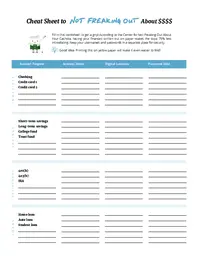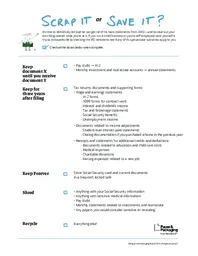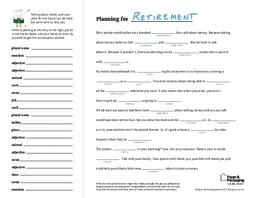
Some things in life are just plain awkward. Unfortunately, they’re often topics of grave importance, such as income, debt, loans and retirement savings. In fact, one survey showed almost half of its participants ranked talking about personal finances as more difficult than discussing death. Womp, womp.
Yes, talking finances is uncomfortable, but if money talks, so should you. Lean into the awkward with the help of paper—a simple yet resourceful tool that can help pave the way for families to discuss and create financial preparedness plans.
So, um, I don’t even know where to start ...
That’s OK! Start with paper. Do you have some bills, pay stubs or tax returns sitting around the house? Grab any papers you can easily locate and start whittling down what you need. Use this cheat sheet as a guide for what to consider gathering before kicking off a talk, not to be confused with “the talk.” (See, some topics are more awkward than money.)
This talk can be as narrow or specific as you like. It can even be: “Let’s each determine what we make and have saved before dinner tonight and write it on a piece of paper. Then, after dinner, let’s trade papers to share.” Doing this sets up an initial way to touch base in person and on paper that confronts the awkwardness at hand while also allowing all parties the option to avoid saying it out loud—whatever it may be (in this scenario, it’s the specific number of dollars.)
Now that you’ve opened the floodgates, you may as well surf right into them. Your board? The cheat sheet above. After you download and print it, begin addressing the prompts by writing down your accounts’ names, their digital locations and even password hints to stay organized.
Once you’ve got everything on paper, it’s a bit easier to flounder your way into asking and answering that next awkward, money-related question: “So, um, how much money does that university cost if our daughter doesn’t get the scholarship she’s hoping for?”
It’s just like ripping off a bandage. You’ve got this.
Hey honey, what are all these things piled up on the floor by your desk?
If you or your partner already have all your financial papers, you might be looking for a way to bring up the conversation about the difference between being prepared versus being a hoarder. Rest assured, you don’t need to keep every document. Download and print this financial planning checklist to help determine which papers to keep and which to toss or recycle. Sure, you’re still going to have to ask the one uncomfortable question, but you’ll also be providing a long-term organizational solution.
Errr, I know what I need to discuss, but I just don’t want to …
Got that churning in your stomach about the financial discussion you’re avoiding? Put yourself out of your own misery. It’s not as hard to get started as you may think. Here are a few tips to get family members involved and open up a dialogue to tackle the topic of money.
Pick the right time. Don’t decide to have a “show me the money” talk about college while your kids are cramming for their finals, or discuss retirement savings after your refrigerator just broke. Tip: Put a sticky note in your kids’ school agendas as a reminder.
Print an agenda for family financial planning discussions. Doing this helps put everyone on the same page, literally, and it gives family members something to hold onto and a place to take notes.
Start with a question. Give members of your family a voice in the matter instead of demanding a talk. Hand everyone a piece of paper and ask them to write down their answers. What you ask depends on your family’s financial wants and needs (whether you’ve got kids going to college soon, new appliances to buy or a vacation coming up). After a few related questions, ask your family members to share their answers. Then, open up the floor for discussion.
If it seems harsh to ask direct questions right off the bat, download and print these fill-in-the-blank sheets as an icebreaker. Pass them out and have family members fill in their answers. Then, share what everyone came up with to kick off your conversation.
Write down goals. Give each participant a sheet of paper. Before you adjourn, ask everyone to write down his or her next steps on a piece of paper. Add a deadline for the next steps and everyone will have a paper takeaway that will help keep your family’s financial planning and preparedness top of mind.
Remember: The idea is to walk away with goals that will eventually leave your family financially prepared. You have to start somewhere, and introducing paper to the equation is a great place to begin.
If you're looking for more ways to stay organized, take a look at these printable templates.







